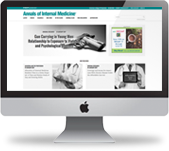Lessening EHR burden through alert, message settings
As a critical first step, practices and systems should gather data on the frequency and type of each alert or message and actions taken in response to them.
Electronic health records (EHRs) and medical device systems are indisputable contributors to clinician burden, often through disruptions to cognitive processes and workflows. Two features of these technologies—alerts and inbox messages—have been identified as significant sources of burden and threats to patient safety. ACP recently issued a position statement in fall 2024 to guide physicians, health care systems, and EHR vendors in safely reducing alert fatigue and messaging burden.
High-frequency interruptions from low-value alerts (sometimes called “alarms”) can lead to cognitive overload and alerts being ignored. The recurring disruptions to cognitive load from alerts and messages might additionally have implications for diagnostic accuracy, posing a potential threat to patient safety. The prevalence of alarm-related safety events has been consistently high enough that The Joint Commission has included clinical alarm safety improvement among its National Hospital Patient Safety Goals every year in the past decade and nearly every year since these goals were introduced in 2002. The relationship between attention, EHR design (including alert and messaging features), and patient safety was the subject of a scoping review published June 18, 2024, by Annals of Internal Medicine. In addition to problematic alert features, inbox messages to physicians and their care teams have noticeably increased in recent years with the growing use of telemedicine and remote patient care.
As a critical first step to addressing these issues, practices and systems should gather data on the frequency and type of each alert or message and actions taken in response to them. Physician practices and health care systems should determine which alert and message types should go to the physician specifically and which are more appropriately addressed by another member of the clinical care team. Additionally, alerts and messages should be streamlined so that the physician is rarely the first person on the care team to see them and never the first member of the care team to receive those of low value.
Clinicians should have conversations in their practice or with health care system administrators about improved workflows and approaches to addressing different types of alerts and messages. Feature settings and workflow parameters should be optimized so that members of the clinical care team, especially physicians, can focus on doing what only they can do, enabling each member to practice at the top of their license.
Health care systems should include physicians in designing and testing new alert and messaging features, and new features need to be tested by clinicians not involved in the product's design or operation. End users should have discretionary power over such features, including their settings.
EHR vendors should also be responsible for developing and making freely available standard default features that automatically log alerts and message volume by category. Physicians and health care systems can use these data to improve EHR alert and messaging settings to reduce or eliminate low-value alerts, including settings for who receives each category of alerts and messages.
Artificial intelligence and machine learning technologies may also offer promise in safely and efficiently lessening the burden from EHR alerts and messages, including assessments of less intrusive ways of averting the harm or potential harm signaled through alerts and safe and appropriate ways to address or respond to messages from patients and other members of the clinical care team.
Implementing these policy principles will enable physician practices and health care systems to safely reduce the frequency of low-value alerts and channel messages to the most appropriate care team members, helping to reduce clinician burden, boost productivity, and lessen these technology-related risks to patient safety.
ACP offers additional information and tips on lessening burden from inbox messages in a members-only informational webinar by Lisa Rotenstein, MD, MBA, MSc.




